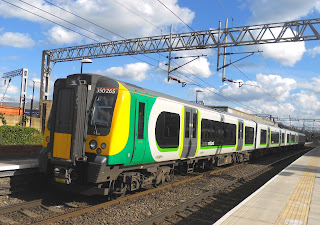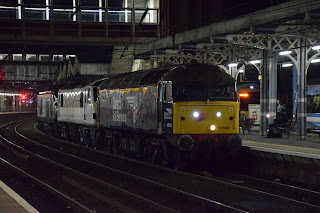Peter Skuce Reports (5A - WCML)
During the early 1960s, British Railways commenced a major electrification and modernisation of the West Coast Main Line between London Euston - Crewe and Liverpool/Manchester. Electrification was completed by 1965, with regular service from Easter 1966. The route was the first in the country to be energised at the now standard 25,000 Volts alternating current and featured the chunky heavy duty, sturdy steel gantries holding both the catenary wire and contact wire itself (it is this latter wire that the train’s pantograph receives electricity from). At the same time the signalling was modernised from semaphore to colour light signals. The through trains to Glasgow Central, such as 'The Royal Scot', were hauled by Class 40 Diesel Electric locomotives.
The station buildings of Hemel Hempstead, Coventry, Birmingham New Street and London Euston were demolished and rebuilt. Both London Euston and Birmingham New Street became similar in appearance and style to an airport terminal with their own ticket sale travel centres and ‘state of the art’ waiter/waitress served restaurants. The famous Doric Arch at London Euston got dismantled and thrown into a canal.
In order to haul the express intercity trains and freight traffic, British Railways ordered twenty five Class 81 AC Electric Locomotives from AEI, British Railways themselves built forty Class 85 AC Electric Locomotives and finally built/ordered a hundred Class 86 AC Electric Locomotives (forty built by British Railways and sixty built by English Electric). The Class 86 were the most successful design and was powered by four AEI 282BZ traction motors with a top speed of 100 MPH and 4,000 horsepower to haul the express Intercity trains. All locos were painted in Electric Blue livery and a depot was built at Willesden. They were to haul long rakes of Mark 2 carriages with each First Class carriage seating 42 and each Standard Class carriage seating 64. Most trains featured a Mark 1 buffet carriage and some other trains also featured a Mark 1 Restaurant Car to serve breakfast, lunch or dinner to fare paying passengers. A separate, dedicated batch of Mark 2 carriages were built to Pullman standards to work the prestigious Manchester Pullman express.
British Railways constructed fifty 4 carriage length Class 310 AC Electric Multiple Units for the London Euston – Milton Keynes Central – Northampton – Birmingham New Street, Coventry – Birmingham New Street – Wolverhampton and Birmingham New Street – Walsall suburban services. These had a top speed of 75 mph and had capacity for 24 First Class and 290 Standard Class passengers. A depot was built at Bletchley to maintain and service the trains.
Then in 1970s, British Rail extended the electrification north of Crewe to Glasgow Central and this was completed in 1974. A batch of thirty five Class 87 AC Electric Locomotives were built to handle the traffic and were nicknamed ‘Electric Scot’. They were delivered in Rail Blue livery, were powered by four GEC 412AZ traction motors and had a top speed of 100 mph (increased to 110 mph upon fitment of Brecknell Willis high speed pantograph from mid 1980s) and 5,000 horsepower. Due to the Class 87 being air braked only, they were not permitted to work the Manchester Pullman trains. At the same time, British Rail built Mark 3A carriages, same design as High Speed Train Mark 3 trailers and the same livery of Rail Blue and Grey, with each First Class carriage seating 48 and each Standard Class carriage seating 74. In addition to these standard types of carriages being constructed, British Rail constructed some Mark 3A Restaurant First Modular Catering carriages with a total of 24 seats.
Peter Skuce. Part 2 of this post is tomorrow.








